Perhaps most famous for its role in rainbow-hued, irresistibly wiggly Jell-O, gelatin is actually a standalone cooking ingredient whose usefulness extends surprisingly far beyond this simple dessert. It is an important component in many other recipes for the way it provides thickness and structure, and therefore can seem like a bit of a trick to swap out in favor of a plant based option!
For this reason, we have gathered together our 8 favorite vegan and vegetarian gelatin substitutes and will cover everything from the pros and cons of each to how to incorporate them into your recipe. Whether your aim is to master the wide range of gelatin-based desserts and pastries, or you simply are craving a pile of juicy Jell-O like dessert, we have the vegan gelatin substitute you need!
Table of Contents
What is Gelatin?
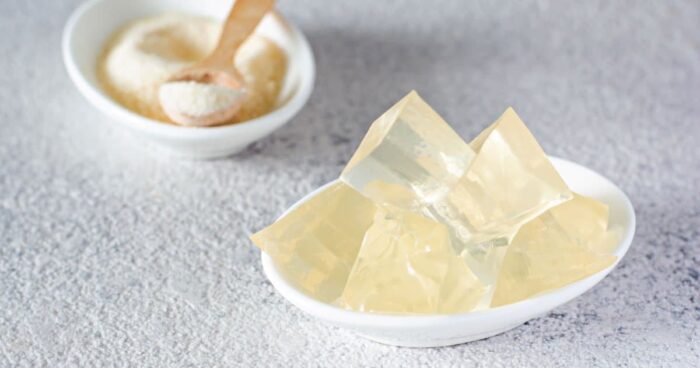
Gelatin is essentially rendered collagen from non-muscular animal parts that have been boiled for quite some time. It comes in several different forms, from gelatin powder or granules to gelatin sheets--which must be soaked in water prior to incorporation into a recipe.
Aside from being mixed with sugar, flavor, and food coloring to produce Jell-O desserts, gelatin is also used in dishes such as panna cotta, ice cream, pudding, gummy-style candies, fruit glazes, cream fillings, and marshmallows to name a few.
Gelatin is most widely associated with piles of wobbly cubes, but in recipes, the substance is far less obvious. Rather, it serves to provide structure and firmness to dishes that would otherwise be very liquidy.
A Few Important Characteristics of Gelatin
When seeking vegan substitutes for gelatin, it’s important that we understand the specific traits of this substance that we are aiming to replicate or at the very least, get close to.
Regular gelatin is:
- Colorless. We know, we know, those boxes of Jell-O desserts are anything but colorless! In its natural form however, gelatin is clear or very nearly clear, meaning it won’t add any coloring or cloudiness to your recipes where it would be unwanted.
- Flavorless & Odorless. Regular gelatin in its pure form is also essentially tasteless and odorless, allowing it to be used in a wide range of recipes and flavor profiles.
- “Jelly-Like” in Structure. While the exact jiggle of gelatin is tough to replicate, it is important that a vegan gelatin substitute offers at least some level of jelly-like texture and viscosity.
- Water Soluble. Gelatin readily dissolves in water, which allows it to easily disperse throughout liquid ingredients, setting up the overall structure of the recipe.
Top 8 Vegan Gelatin Substitutes
There’s no doubt about it, gelatin is an extremely unique product, therefore its role can be a bit difficult to fill. But thankfully, there are several plant based options you can use to replace gelatin in a recipe. Our favorite vegan gelatin substitutes are:
1. Agar Agar
2. Carrageenan
3. Cornstarch
4. Pectin
5. Xanthan Gum
6. Instant Clear Jel
7. Guar Gum
8. Store-Bought Vegan Gelatin Products
Allergy Note: While all of these substitute options are gluten free (always double check the packaging though!), some folks may find that not all of these products are suited for their eating plan. Pectin, which is derived from fruits, may not be suitable for those with certain fruit allergies, while other people may choose to avoid carrageenan due to the continuing controversy over its health effects. We’ll go into greater detail on these issues in each section as needed!
1. Agar Agar
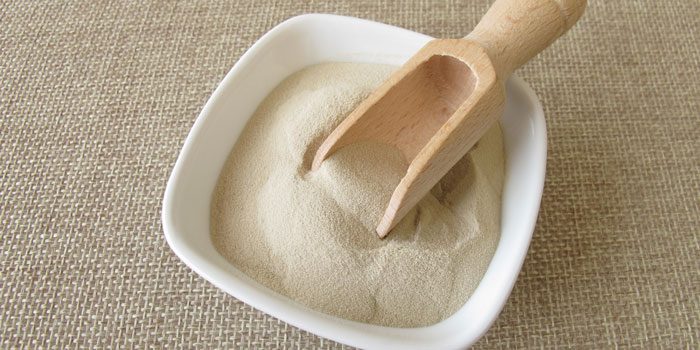
When it comes to replacing gelatin in a recipe, agar agar is without a doubt the number 1 go-to! Made from red algae, this substance is odorless and tasteless, albeit not quite as clear as traditional gelatin. When mixed with water, agar powder results in an excellent gelatinous texture, although it is a bit less wiggly and more structured as compared to regular gelatin. This makes agar agar perfect as a firming agent in custard-based desserts, mousses, puddings, or fruit gels.
Just like gelatin, you’ll need to dissolve the agar in warm water before it can be incorporated into your recipe and it will not set up until it cools to room temperature. Agar agar comes in powdered or flaked form, both of which are easily dissolved in water and incorporated into recipes. There are also other versions of the substance in strands or bars, and although these are a bit less common, they’ll do the trick as well!
If you find yourself cooking or baking often, you might just opt to keep a bag of powdered agar or agar flakes on hand in your pantry, as it will last for up to a year when kept tightly sealed and in a cool, dark environment.
How to Substitute:
If you are using powdered agar agar, you can replace gelatin in any recipe at a 1:1 ratio. If using agar flakes, you’ll need a bit more so go with a 3:1 ratio of agar agar flakes to the quantity of gelatin your recipe calls for.
Take note that agar has trouble setting in the presence of high acidity, so if your dessert has a lot of citrus juice or other acidity, you may need to up the agar agar amount.
2. Carrageenan
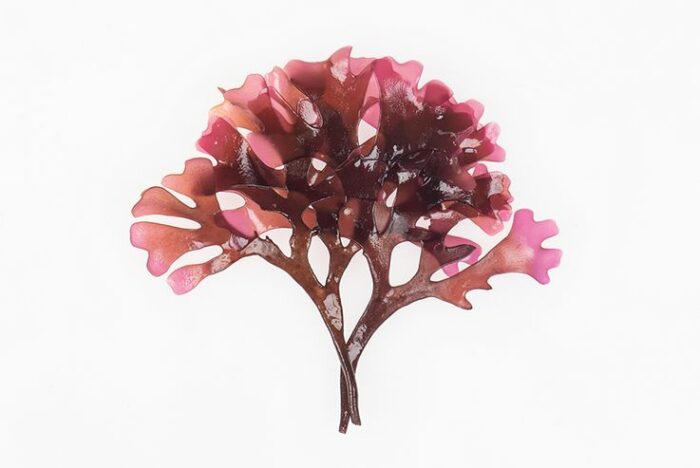
Also known as Irish moss, carrageenan is yet another plant-derived thickener, except this time it is made from red seaweed as opposed to the red algae that produces agar. This stuff is well-known for its ability to give a smooth, gelatinous cohesion to whatever it is added to and is an important ingredient in commercial ice creams, some types of vegan cheese, and other dairy products.
Carrageenan comes in a few different varieties. Iota carrageenan is best used in soft jellies and creamy-style desserts, while kappa carrageenan will fare better in dishes where the aim is to set more firmly. You get this stuff in either powdered form or whole dried seaweed form, each of which will do the job, but it takes a few extra steps to prepare carrageenan from its whole dried state.
How to Substitute:
Using carrageenan is a bit trickier than some of the other vegan substitutes for gelatin as it is measured by weight as opposed to volume. The general ratio, however, is that 1-ounce of carrageenan will gel 1 cup of liquid. For comparison, regular gelatin requires anywhere between 1-3 teaspoons per cup of liquid depending on intended firmness.
Therefore, 1 ounce of carrageenan is roughly equivalent to 1-3 teaspoons of regular gelatin, but you'll have to experiment with your particular ingredients in order to further refine the measure.
3. Cornstarch
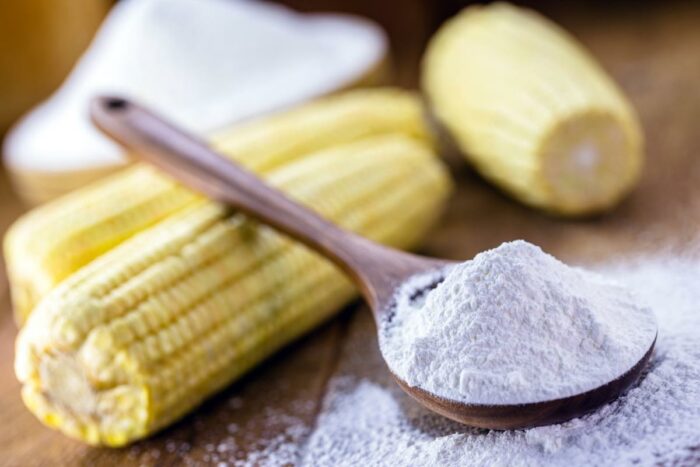
You might already be familiar with cornstarch as an ingredient in baked goods or as a subtle coating for lightly fried foods, but did you know that cornstarch can be used as an effective gelling agent as well? It proves useful as a thickener in sauces such as gravies or fruit compotes like our Blueberry Sauce, but in higher quantities, cornstarch can also help desserts to set up and give them just a bit of wiggle.
You can’t use cornstarch to make jelly or gelatin-like desserts, but you can use it to substitute gelatin in recipes like sauces or fruit toppings. Keep in mind that in order for cornstarch to activate and thicken, it must be simmered for several minutes. Also, unlike typical gelatin and replacements like agar agar, cornstarch will not set up much as it cools, so be sure that you have achieved your desired consistency before you remove it from the heat.
How to Substitute:
Combine an equal amount of cornstarch and water in a bowl or lidded container, then whisk or shake until the mixture is cohesive. You’ll need anywhere between 1-2 tablespoons of this slurry mixture per 1 cup of liquid in your recipe.
4. Pectin
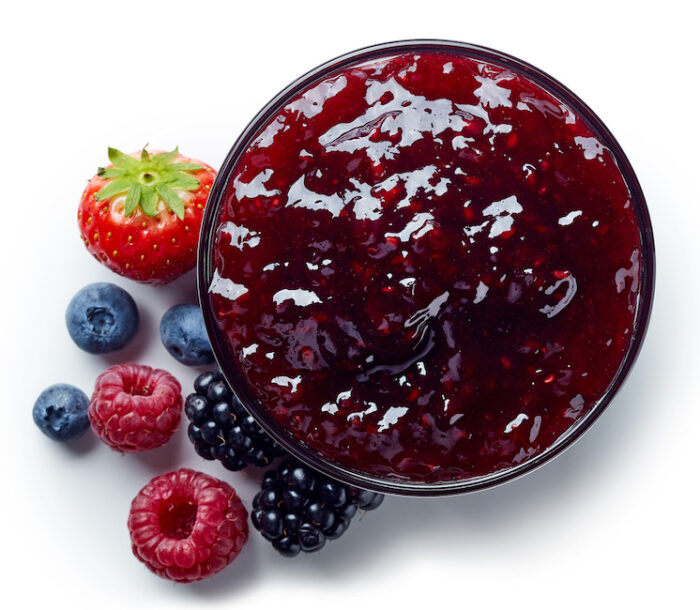
It’s no secret that pectin plays a key role in jams and jellies (most typical jelly is vegan jelly, by the way!), but you might not know that this gelling agent can also be used to replace gelatin in other recipes as well!
Pectin is a fibrous plant compound, which although found in many types of fruits and vegetables, is especially high in apples and citrus fruits. And, as a soluble fiber, pectin comes with the added bonus of providing some health benefits!
While you could slowly simmer your own chopped fruits to extract the pectin, this stuff thankfully comes pre-packaged as powder or flakes. It’s worth noting that pectin generally requires both heat and the presence of sugar to gel up, so using this in savory recipes is unlikely to pan out.
How to Substitute:
When it comes to this one, it’s unfortunately a bit of a case by case basis. You’ll have to play around with your recipes in order to determine how much pectin to use in place of gelatin in order to garner the effect you’re looking for.
5. Xanthan Gum
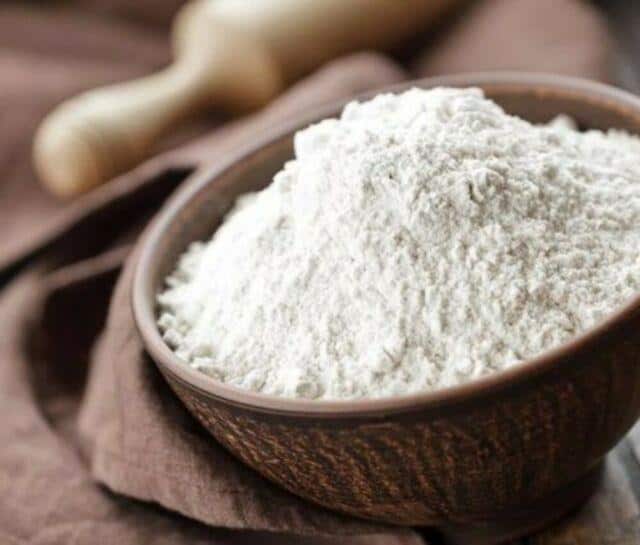
You are probably already familiar with xanthan gum as an ingredient in processed food items or as a crucial component of your favorite gluten free recipes. Derived from corn, this sticky substance is produced as a result of sugar fermentation. Once collected, the gum is dried and powdered, making it quite simple to rehydrate and use as a thickening agent in baked goods or as a stabilizer in sauces.
Xanthan gum will not gel in the same way as gelatin or some of the other vegan substitutes we’ve already covered, but it can be useful in some instances such as when making a thickened filling--such as in our Vegan Key Lime Pie, or to make a glaze such as those you typically see polishing the tops of fresh fruit tarts.
How to Substitute:
For the quantity of gelatin your recipe calls for, you want to use half as much xanthan gum. For example, if your recipe requires 2 teaspoons of gelatin, use just 1 teaspoon of xanthan.
When working with xanthan and liquids, it’s important to thoroughly combine the powder with the liquid ingredients as it gels instantly on contact. If possible, combine your liquid ingredients in a high speed blender and slowly add the xanthan while the machine is running to avoid any clumping.
6. Instant Clear Jel
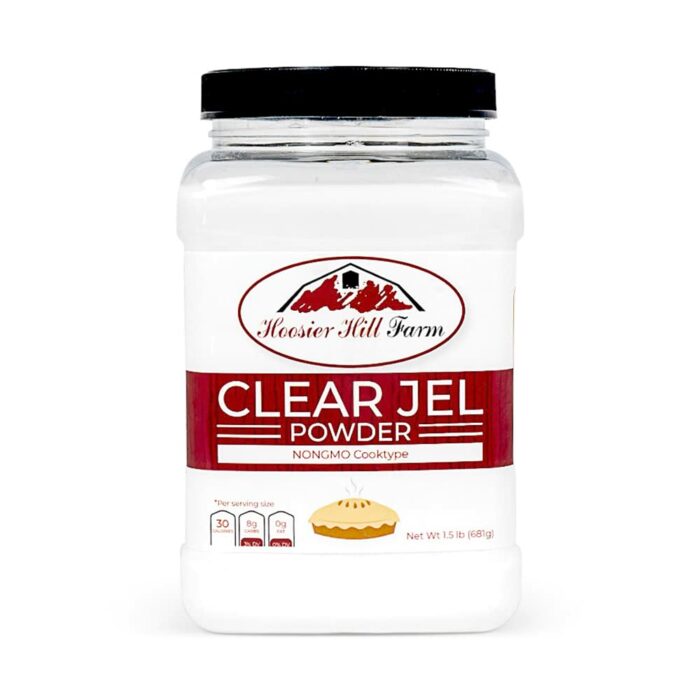
On first glance you might think that this product is just your average cornstarch, but this is not quite the case! Although derived from the same source, the key difference here is that most clear jel products do not require heat to unleash their thickening powers, meaning this is a great plant based alternative for dishes that don’t get cooked. Think velvety cream pies and luxurious fresh fruit sauces.
Using clear jel as a vegan substitute for gelatin won’t result in a firm gel, but it will have a gummy, soft gelatin texture. Also keep in mind there are some clear jel products which are intended for use in cooked dishes so be sure to reach for the one that suits your needs.
How to Substitute:
Generally speaking, 1 tablespoon of instant clear jel will thicken 1 cup of liquid. This ratio could vary depending on the other characteristics of the dessert such as any naturally occurring pectin in the fruit, if present.
7. Guar Gum
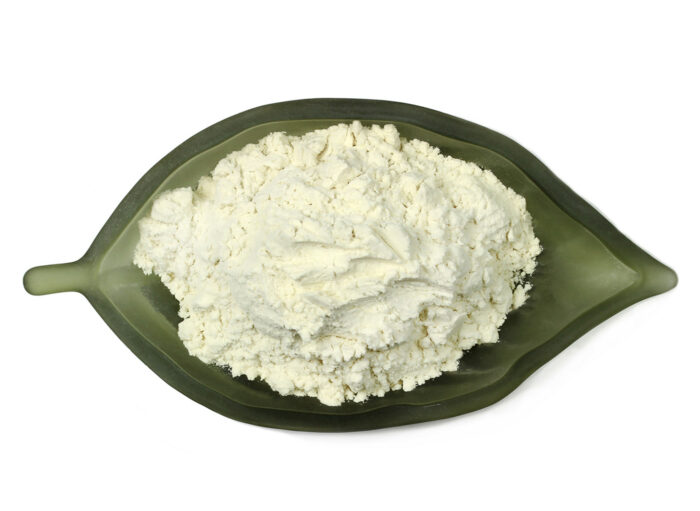
Guar gum is another type of vegetable gum which, when compared to xanthan gum, is a bit less predictable as far as how it will behave in a recipe. Nevertheless, it definitely makes the list of vegan substitutes for gelatin as it can produce a gel-like consistency when certain conditions are right.
Made from the guar bean--which looks a lot like your average green bean--this substance is a common ingredient in a ton of prepared food products and is also widely used for industrial purposes as well. Talk about a multi-tasker! This stuff will help with structure in baked goods as well as bring smoothness and soft gelatinization to desserts like puddings and ice creams.
How to Substitute:
When it comes to guar gum, a little goes a long way. Just a ½ teaspoon of guar gum can thicken 1 cup of liquid. This means that you can replace gelatin with guar gum at a ratio of 5:1, substituting the amount of gelatin called for with one-fifth as much guar gum.
That math is a little tricky, so here are a few examples:
- Replace 1 teaspoon of gelatin with a scant ¼ teaspoon of guar gum.
- Replace 2½ teaspoons of gelatin with ½ teaspoon of guar gum.
- Replace 1 tablespoon of gelatin with a scant ⅔ teaspoon of guar gum.
8. Store-Bought Vegan Gelatin Products
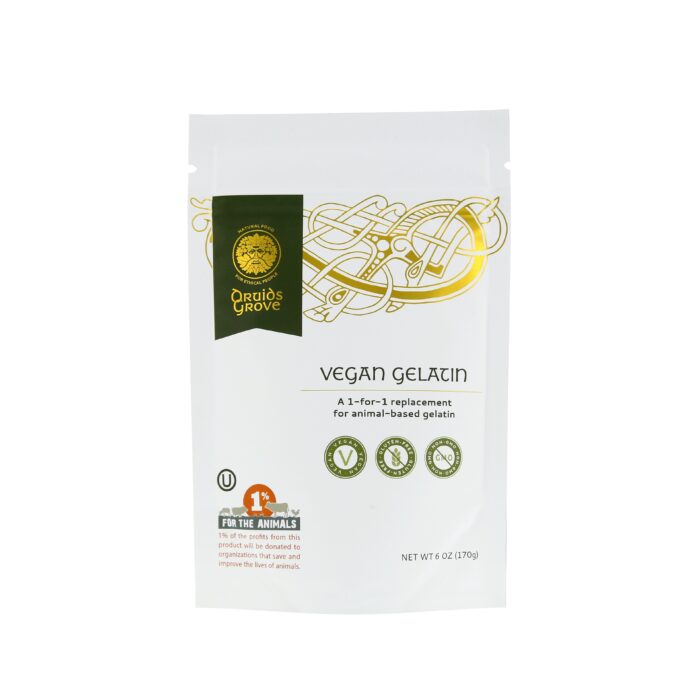
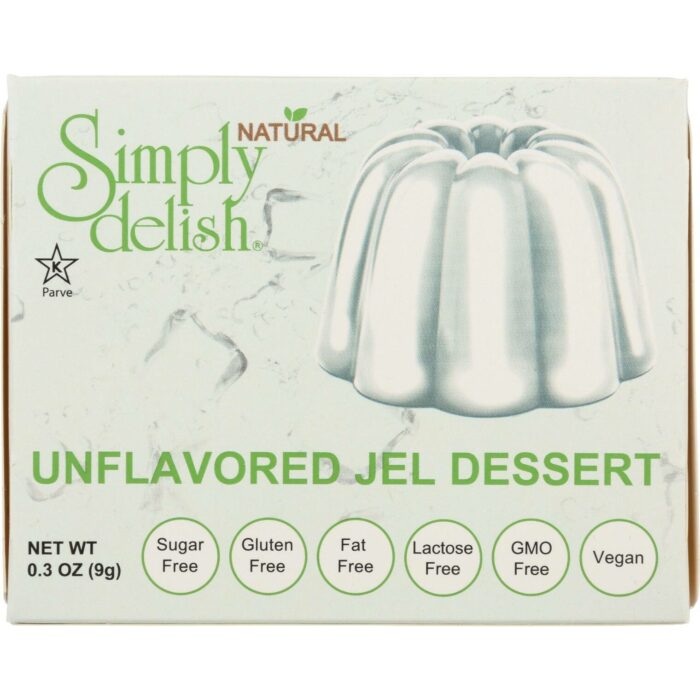
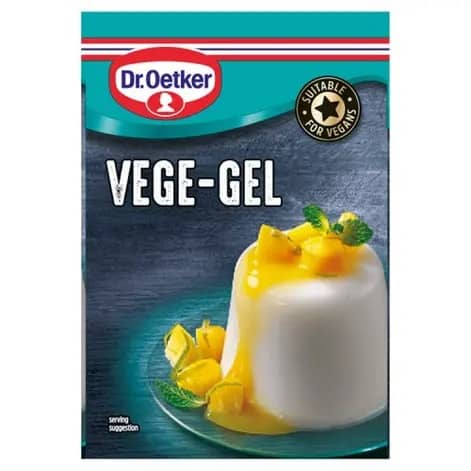
Last but not least, there are actually several store-bought products out there that are specifically designed as a vegan gelatin alternative. This means that yes, you can make vegan Jell-O style desserts or use them for a whole host of other purposes.
These products are made from a specific combination of the ingredients we’ve already discussed–namely carrageenan mixed with flavorings, sweeteners, coloring, and potassium citrate (to keep the acidity balanced). These vegan jel products are also available in plain, unflavored options so that you can use your own favorite juices or sweeteners or as part of a larger recipe.
How to Substitute:
These store-bought vegan gelatin substitutes are intended to be used as a 1:1 replacement for regular gelatin in most any recipe. Or, follow the instructions printed on the packaging for an excellent fruit gelatin-style treat!
7 Great Vegan Substitutes for Gelatin: The Takeaway
Surprisingly enough, it's not all that complicated to find a vegan replacement for gelatin--an animal product which is rather complicated to say the least!
Agar agar is and always will be your best bet, as it can do just about any of the things regular gelatin can, while other ingredients like cornstarch and xanthan gum can work in some instances but not others.
If you find yourself in need of a vegan gelatin substitute rather often, go ahead and keep your cabinet stocked with some store bought vegan gelatin options. They have just the right combination of ingredients to whip up a suitable Jell-O like dessert or to be used in baking and cooking recipes.


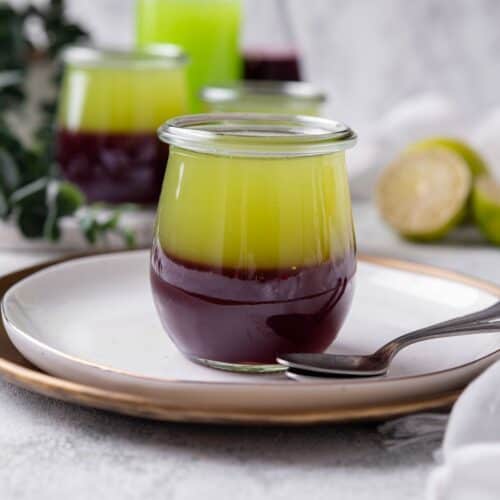

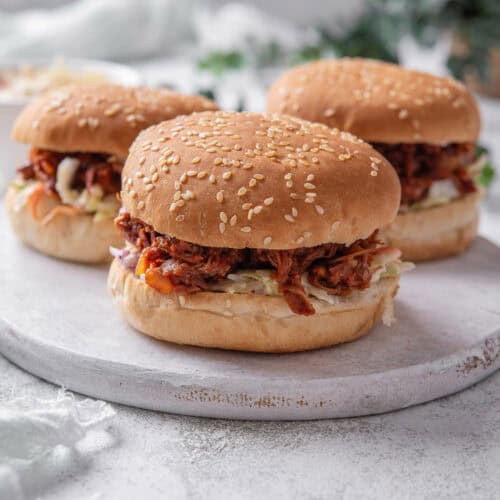
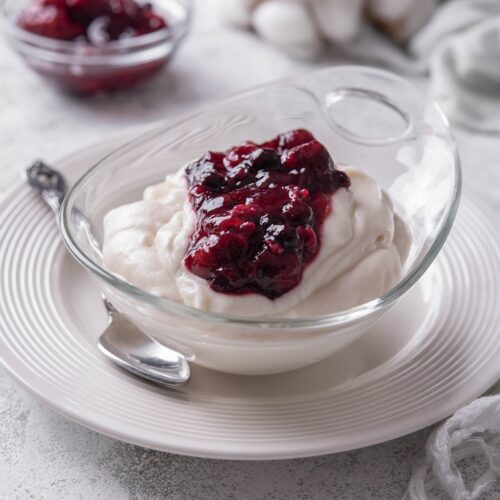


Leave a Reply